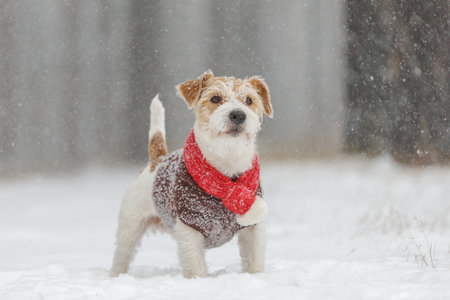Introduction to Seasonal Pet Care in Britain
Britain’s famously unpredictable weather and clearly defined seasons present unique challenges for small pet owners. From the brisk chills of a rainy spring to the rare, but intense, summer heatwaves, each season brings its own set of considerations for keeping rabbits, guinea pigs, hamsters, and other tiny companions healthy and happy. Preparing for these changes isn’t just about comfort—it’s essential for your pet’s wellbeing. Understanding how temperature shifts, dampness, and fluctuating daylight hours affect your furry friends will help you select the right accessories and supplies throughout the year. In this guide, we’ll explore how to anticipate seasonal needs and ensure your small pets thrive whatever the British weather brings.
Essential Winter Gear for Small Pets
When the British winter sets in, small pets like rabbits, guinea pigs, and ferrets need extra protection against the cold, damp, and wind. Unlike their wild counterparts, our pampered companions rely on us to keep them safe and comfortable throughout the chilly season. Equipping your pets with the right winter accessories not only keeps them healthy but also ensures they thrive even when frost bites outside.
Insulated Hutches: First Line of Defence
British winters can be unpredictable, swinging from drizzle to snow overnight. A sturdy, insulated hutch is essential for outdoor pets. Look for models with double walls or add insulation panels yourself. Place hutches in sheltered areas away from prevailing winds and raise them off the ground to prevent damp rising. Remember, a well-insulated hutch retains warmth while allowing adequate ventilation to avoid condensation and respiratory issues.
Thermal Bedding: Cosy Comforts
Your pet’s bedding should provide warmth without compromising hygiene. Swap out light summer bedding for thick layers of hay, shredded paper, or vet-approved fleece liners. Thermal bedding and heat pads are popular choices—especially those designed to be microwaved and safely tucked beneath nesting material. Below is a quick comparison of popular thermal bedding options in Britain:
| Bedding Type | Warmth Level | Maintenance | Best For |
|---|---|---|---|
| Hay & Straw | Moderate | Frequent changing needed | Rabbits, Guinea Pigs |
| Fleece Liners | High (with layers) | Machine washable | Indoor/Outdoor use |
| Microwavable Heat Pads | Very High (short-term) | Wipe clean after use | Elderly or unwell pets |
Draught-Proofing Tips
Britain’s blustery winds make draught-proofing a must. Use hutch covers made from heavy-duty tarpaulin or fitted weatherproof materials—these are widely available at UK pet stores and online retailers. Ensure any covering still allows fresh air to circulate; never completely seal a hutch as this risks dampness and poor ventilation. For indoor cages near windows or doors, move them away from direct draughts and consider using room thermometers to monitor temperature changes.
Caring for Small Pets During Cold Snaps
If you’re facing a particularly harsh winter spell, check on your pets more frequently. Replace wet bedding promptly and ensure water bottles don’t freeze by using insulated covers or switching to bowls if necessary. Regularly inspect hutches for leaks or signs of chewing that could compromise insulation.
A Real-World Example from Britain
This past January in Manchester, my guinea pigs’ hutch was fitted with an insulated cover and lined with deep straw layered over fleece liners. Despite several nights dropping below freezing, both stayed warm and active—thanks to daily checks, fresh bedding, and a trusty microwavable heat pad tucked into their nest each evening.

3. Springtime Supplies and Hazards
As the chill of winter finally thaws across Britain, spring brings a fresh wave of energy—and a unique set of challenges—for small pet owners. The transition from the colder months means it’s time to rethink both your pet’s environment and their daily routine. Many small pets, such as guinea pigs, rabbits, and ferrets, may have become accustomed to extra bedding and cosier quarters during winter. As temperatures rise, gradually reduce heavy bedding materials, but be mindful of lingering cold snaps common in British springs; keep lightweight blankets or hutch covers handy for those unpredictable frosty nights.
Fresh Forage: A Springtime Treat
With new growth sprouting in gardens and parks, spring offers an abundance of fresh forage for your furry companions. Dandelion leaves, clover, and fresh grass can all be wonderful additions to their diet—just be sure these are picked from pesticide-free areas away from busy roads. Always introduce new greens slowly to avoid upsetting sensitive tummies, and remember that sudden dietary changes can cause digestive issues.
Managing Allergies
The British spring is notorious for triggering allergies—not just in humans, but in pets as well. Pollen levels soar, which can leave sensitive pets sneezing or scratching more than usual. Keep hutches and cages well-ventilated but protected from drafts, and consider using air filters indoors if your small pets are particularly prone to respiratory irritation. Regularly brushing out fur helps remove pollen that may cling after outdoor playtime.
Mud and Dampness: The Hidden Menace
April showers (and often May ones too) mean mud is par for the course in British gardens. Wet conditions can easily lead to sore feet or fungal infections in small animals who spend time outdoors. Place sturdy mats at hutch entrances, check paws daily for signs of irritation, and keep bedding dry by changing it more frequently during damp spells. Ensuring your pet’s home is slightly elevated will help prevent water from seeping in on rainy days.
Spring is a season of renewal but also requires extra vigilance from UK pet owners. With thoughtful adjustments to accessories and supplies—and a keen eye for seasonal hazards—you’ll ensure your special companions enjoy the best of British springtime safely.
4. Summer Cooling Essentials
British summers may be brief and unpredictable, but when a heatwave does strike, our small pets can feel the effects acutely. Unlike us, they cant sweat or easily escape the heat, so its essential to take proactive measures to keep them comfortable and safe. Here’s how you can help your little companions beat the rare British heat:
Cooling Mats and Accessories
Special cooling mats are a fantastic way to provide instant relief for your pets. These mats often contain gel that activates with pressure—no need for electricity or freezing. Place one in your pets favourite lounging spot, whether it’s the corner of a rabbit hutch or the floor of a guinea pig run. Other accessories like frozen ceramic tiles or chilled water bottles (wrapped in a tea towel) can also create cool zones.
Safe Hydration Tips
Hydration is critical in warm weather, especially for small animals who dehydrate quickly. Always ensure clean, fresh water is available. Consider using ceramic bowls rather than plastic ones, as they keep water cooler for longer and are harder to tip over. For very hot spells, add an extra water source just in case one gets knocked over or becomes warm too quickly.
| Pet Type | Preferred Water Source | Cooling Accessory |
|---|---|---|
| Rabbits | Ceramic Bowl | Gel Cooling Mat |
| Guinea Pigs | Bottle & Bowl Combo | Chilled Tile |
| Hamsters/Mice | Bottle Feeder | Frozen Bottle (outside cage) |
Providing Proper Shade
If your pets enjoy time outdoors, always ensure their run or hutch is positioned out of direct sunlight during peak hours (11am–3pm). Use breathable covers like old sheets or purpose-made sunshades to create dappled light without blocking airflow. Indoors, keep cages away from sunny windows and consider closing curtains during the hottest part of the day.
Quick Checklist: Keeping Small Pets Cool in Summer
- Monitor temperature in hutches and cages—aim for under 22°C where possible.
- Refresh water supplies morning and evening.
- Add extra shade if moving runs daily isn’t feasible.
- Avoid handling pets excessively during heatwaves—they’ll appreciate being left to rest.
- Watch for signs of heat stress: lethargy, panting, drooling, or red ears mean you should act fast.
Your Summer Pet Care Routine
A bit of planning goes a long way when it comes to summer care for small pets in Britain. By investing in the right accessories and paying attention to hydration and shade, you’ll help your furry friends stay happy and healthy even on those rare hot days.
5. Autumn Adjustments and Accessories
As the British autumn sweeps in, small pet owners face the double challenge of cooling temperatures and an almost predictable increase in rainfall. This is when the resilience of your pet’s environment is truly put to the test. For those keeping rabbits, guinea pigs, or even ferrets in outdoor hutches, now is the time to consider weather-resistant upgrades. Opt for hutches that feature sturdy roofing with a slight incline for runoff, raised bases to avoid soggy bedding, and proper insulation such as thermal covers or thick, chew-safe blankets. These not only keep the chill out but also protect against relentless dampness—a notorious British nemesis.
With daylight hours dwindling and rainclouds ever-present, you’ll likely find your pets spending more time indoors. This shift means rethinking their enrichment: boredom-busting toys, tunnels, and hideaways become essential. Scatter feeding and interactive puzzles can help mimic natural behaviours and keep them mentally stimulated during longer spells inside. Don’t forget that increased indoor time can also mean less exercise, so dedicating a secure, pet-proofed area for free roaming is invaluable. As always, regular health checks are crucial—autumn dampness can bring respiratory woes or fungal issues if habitats aren’t kept dry and clean.
From my own experience raising a pair of cheeky degus in Manchester’s famously rainy autumns, I found that lining their enclosure base with extra-absorbent bedding was a game-changer. I also invested in a waterproof cover for their playpen and rotated toys to keep them curious during gloomy afternoons. The key is embracing the season’s quirks: prepare early, observe your pets’ behaviour closely, and tweak their setup as needed to ensure they stay cosy, dry, and entertained right through until winter sets in.
6. Year-Round British Pet Essentials
No matter the season, certain accessories and supplies remain fundamental for keeping your small pets healthy and content throughout the unpredictable British year. For housing, look for robust hutches or cages from trusted UK brands like Omlet and Pets at Home, ensuring they are well-insulated yet breathable—crucial for coping with both chilly winters and muggy summers. Bedding is another staple; opt for dust-extracted options such as Carefresh or Fitch to keep respiratory issues at bay, especially in our damp climate. Diet is equally important all year round: source high-quality hay (like Burgess Excel) for rabbits and guinea pigs, and choose species-appropriate nuggets or mixes free of added sugars and artificial colours. Regular enrichment is vital—rotate a variety of chew toys, tunnels, and hideouts from local suppliers like Rosewood or Happy Pet to stave off boredom regardless of weather. Don’t forget grooming tools tailored to your pet’s coat type; Furminator brushes or Ancol combs are ideal for routine upkeep and managing seasonal moults. Finally, maintain a well-stocked first aid kit with essentials recommended by UK vets, including antiseptic sprays and critical care formula, so you’re prepared for any minor mishaps whatever the weather throws at us. By relying on quality British brands and staying attentive to your pets’ needs, you’ll ensure their comfort and happiness every day of the year.


